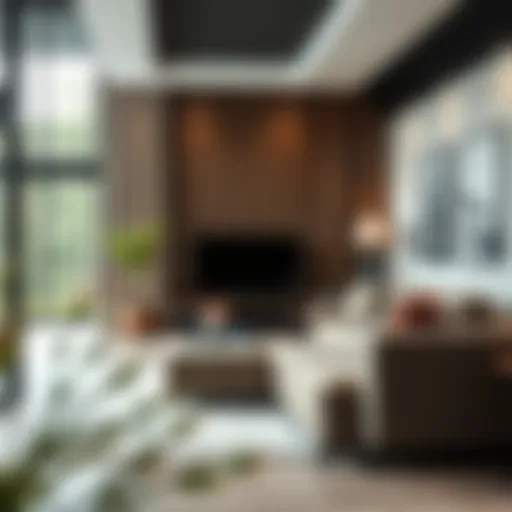Choosing the Right White Cabinet Doors for Your Home

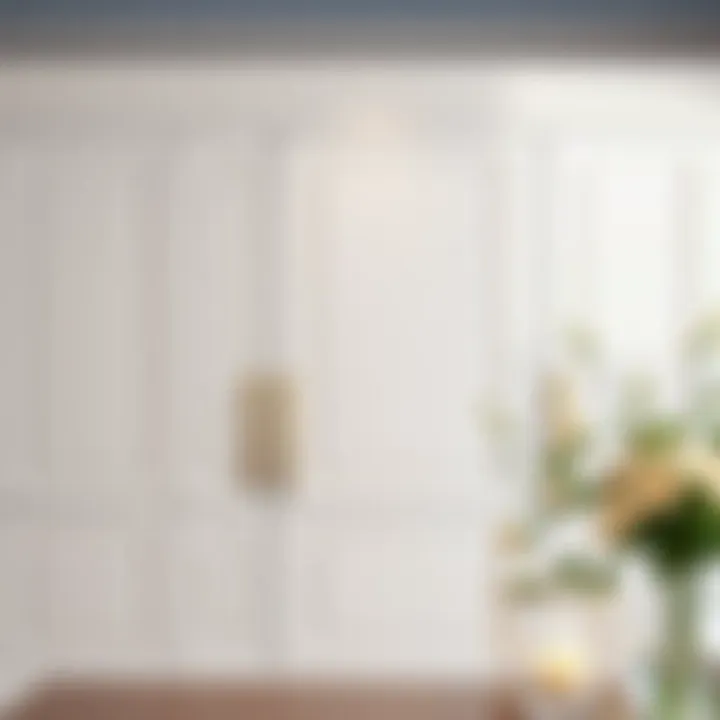
Intro
In the realm of interior design, few elements hold as much potential to transform a space as cabinetry. Particularly, white cabinet doors offer a timeless charm that can suit both traditional and contemporary styles. They reflect light, giving a sense of openness and cleanliness, making them a preferred choice among homeowners, designers, and decorators alike. As you contemplate an update or complete renovation, the details surrounding white cabinet doors become critical: choice of materials, styles, and installation techniques can shape the atmosphere of your living or workspace significantly.
This article navigates through the myriad of options available on the market, helping you assess what suits your taste and functional needs. You'll find crucial insights that cater to both practical and aesthetic considerations, ensuring your decisions not only enhance your environment but also fit within your budget and quality expectations.
Foreword to White Cabinet Doors
The kitchen and bathroom are often the beating hearts of homes, places where we gather, create, and unwind. Consequently, the design of these spaces plays a critical role in shaping our daily experiences. One element that serves as both a functional and aesthetic foundation is cabinet doors, particularly those finished in white. White cabinet doors have not only transcended time but have effectively become a staple in modern decor. Their role extends beyond mere utility; they significantly influence the ambiance of a room.
The Appeal of White Cabinetry
The charm of white cabinetry lies in its versatility. It can seamlessly fit into various design styles, from farmhouse chic to sleek urban apartments. Whiter hues tend to brighten spaces and offer an illusion of spaciousness. Additionally, white cabinets provide an excellent backdrop for vibrant and colorful accessories or appliances. When paired with the right hardware, such as brushed nickel or matte black finishes, these doors can elevate an ordinary kitchen into an inspiring culinary environment.
Consider the way light reflects off white surfaces, casting a warm glow that enhances the overall feel of a room. There’s a certain classic sophistication associated with white cabinetry that attracts both homeowners and designers. They have a universal appeal that makes it easy to refresh outdated designs without an extensive remodel.
"White cabinets serve as a blank canvas, inviting creativity while maintaining timeless elegance."
Purpose and Functionality
The primary function of white cabinet doors is to provide storage, concealing the clutter and chaos of everyday life. However, functionality should not overshadow design; the two must go hand-in-hand. Quality white cabinet doors are often made from materials that can withstand the rigors of daily use. For instance, solid wood offers durability, while engineered materials like MDF and particleboard are lightweight yet functional. Each material type has its strengths and can influence the choice based on how a homeowner uses the space.
Additionally, the purpose of these cabinets extends into enhancing organization. With thoughtfully designed cabinetry, various storage solutions such as pull-out shelves and built-in dividers allow for maximum space efficiency, whether it's storing pots and pans or craft supplies.
In essence, the introduction of white cabinet doors into a home serves to combine style with practicality. Homeowners are increasingly aware that their choices need to marry aesthetic desires with their everyday needs. Engaging with white cabinetry thus reflects a modern understanding of functional design.
Design Styles of White Cabinet Doors
When it comes to selecting white cabinet doors, the design style plays a pivotal role in determining the overall aesthetic and functionality of your space. The style you choose not only sets the mood of the room but also impacts how the cabinetry harmonizes with the existing decor. Today’s market offers a plethora of styles, each with its distinct characteristics, advantages, and considerations to keep in mind. By understanding these styles, homeowners and designers can make informed decisions that resonate with their vision, elevating any room into something truly special.
Shaker Style Cabinets
Shaker style cabinets are renowned for their simplicity and versatility. The design features clean lines and a flat panel, making it an ideal choice for those who favor an understated elegance. Often crafted from hardwoods, their durability is second to none. These cabinets provide a timeless look that fits seamlessly into both traditional and modern kitchens, offering you the flexibility you need.
"Shaker cabinets bring a touch of minimalism that marries form and function beautifully."
One of the standout benefits of Shaker style is its easy adaptability. You can paint or stain them to match any color scheme, although white remains a popular choice for a crisp, clean look. When considering Shaker cabinets, think about hardware details. Brushed nickel or matte black knobs can add just the right touch of contrast, creating a pleasing visual balance.
Flat-Panel Designs
Flat-panel designs take minimalism a step further with their sleek and modern appeal. These cabinets feature a smooth surface without any frames or embellishments, creating a seamless effect that opens up any room. Ideal for contemporary settings, flat-panel cabinets pair wonderfully with bold accents and colorful decor.
Choosing flat-panel cabinets made of durable materials ensures longevity. You might think about opting for MDF with a high-gloss finish or even high-quality laminate, both providing a smooth backdrop while being easy to clean. Consider combining these doors with open shelving or glass-front cabinets for an eye-catching contrast. This creates a layered effect without overwhelming the space.
Raised-Panel Options
Conversely, raised-panel cabinets resonate with those who enjoy a bit more detail in their designs. These cabinets are characterized by their dimensions and contours, showcasing a center panel that juts out from the surrounding frame. Raised-panel doors can evoke a sense of grandeur, working beautifully in more traditional homes or spaces aiming for a rich, sophisticated tone.
When selecting raised-panel options, think about how the paneling coordinates with other elements in your space. For instance, nature-inspired finishes can enhance the richness of wood grains, and white while presenting a fresh appearance. This style is often partnered with intricate molding and trim, offering a visually appealing depth that can be increasingly engaging.
Materials Used in White Cabinet Doors
When considering white cabinet doors, the choice of material plays a pivotal role in overall aesthetics, durability, and maintenance. Each material type offers a distinct set of characteristics, benefits, and challenges, influencing how homeowners and decorators approach their projects. Understanding these variances helps in making informed decisions that can contribute to not only the visual appeal but also the longevity of the cabinets. Here’s a deep dive into the materials that are widely used in crafting white cabinet doors.
MDF and Particleboard
Medium Density Fiberboard (MDF) and particleboard are often popular choices for white cabinet doors, especially in budget-conscious projects. MDF is engineered from wood fibers, wax, and resin, creating a dense and smooth surface that’s perfect for paint finishes. It resists warping and is less prone to cracking over time, making it well-suited for intricate designs.
Benefits of MDF:
- Smooth surface ideal for painting and finishes.
- Cost-efficient compared to solid wood options.
- Less likely to warp than solid wood or plywood.
On the other hand, particleboard is made from smaller wood particles bonded together with adhesive. Although it's generally less robust than MDF, it is lightweight and often used in cabinetry as a low-cost option. Both MDF and particleboard doors typically come with a white laminate or finish.
However, they do have their downsides. These materials can be susceptible to moisture damage, so in areas like kitchens and bathrooms, additional care must be taken to ensure longevity.
Solid Wood Choices
For those who prioritize quality and aesthetics, solid wood doors are the crème de la crème. Choosing the right type of wood can significantly enhance the value of cabinetry, and the classic look of solid wood often fits seamlessly into a variety of design schemes.
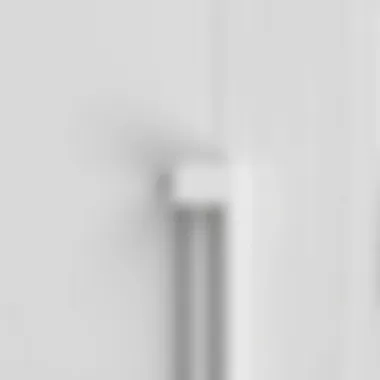

Advantages of Solid Wood Include:
- Exceptional durability and strength.
- Unique grain patterns that showcase craftsmanship.
- Potential for refinishing, allowing for changes over time.
Common woods used for white cabinet doors include maple, oak, and cherry. Each wood type brings its own color and texture, which can be accentuated by proper staining, even when painted white. However, solid wood is susceptible to changes in humidity, which can cause warping or cracking if not maintained properly. This requires more consideration for those living in areas with fluctuating climates.
Plywood Options
Plywood, which consists of layers of wood veneer glued together, presents a middle ground between durability and cost. It offers a strong structure due to its cross-layer construction, making it resistant to warping and suitable for various applications, including cabinetry.
Why Consider Plywood?
- Generally more affordable than solid wood.
- Less susceptible to moisture than MDF or particleboard.
- Can provide a high aesthetic value with both painted and stained finishes.
Plywood can be manufactured with a white finish, making it appealing for modern design aesthetics. Though lightweight and strong, it’s important to ensure the quality when purchasing to avoid lower-grade options that may not hold up well over time.
Laminate vs. Veneer
When it comes to finishing white cabinet doors, laminate and veneer are two popular options that frequently surface in conversation. Both provide different approaches to aesthetics and maintenance.
Laminate is a synthetic material that adheres onto the surface of a cabinet door. It's scratch-resistant and typically easier to clean, making it ideal for high-traffic areas where wear and tear are a concern. Laminate options come in numerous finishes, offering versatile styling choices.
Veneer, on the other hand, consists of thin sheets of real wood glued to a substrate, like MDF or particleboard. This gives the appearance of wood while maintaining a more budget-friendly profile. While veneer provides authenticity and warmth in design, it can be prone to damage from water and may require more careful handling and maintenance than laminate.
Ultimately, the choice between laminate and veneer often comes down to personal preference and the specific needs of your space. Both materials present valid advantages, but understanding their nuances helps in deciding which aligns with your vision.
"Choosing the right material for your white cabinet doors can transform not just the look, but the entire feel of your space."
Customization and Personalization
When diving into the world of white cabinet doors, customization and personalization stand as vital pillars. This facet allows homeowners and decorators alike to tailor their selections according to specific tastes, functionality, and decorative aspirations. As trends lean toward individuality, understanding the avenues available to customize your white cabinetry can truly elevate a space from ordinary to extraordinary.
Custom Finishes
Custom finishes can make or break the overall aesthetic of your cabinets. White may be a popular choice, but the shade of white has myriad nuances. Homeowners can select from brilliant white, which shines like freshly laundered sheets, to off-white, offering a softer, more romantic feel reminiscent of antique decor. The finish you choose can significantly impact the durability and maintenance of the cabinetry as well.
- Satin Finish: This option offers a gentle sheen that’s easier to clean without revealing every smudge.
- Matte Finish: While this gives a more contemporary look, it can be more prone to showing dirt and fingerprints, demanding a bit more elbow grease when cleaning.
- Gloss Finish: If you're aiming for a modern vibe, a glossy finish reflects light beautifully while maximizing longevity.
By opting for a custom finish, you can also think about textures. A textured finish might introduce organic layers that enhance tactile interaction, thus marrying form and function.
Hardware Selection
When it comes to hardware, the adage "the devil is in the details" rings true. The right knobs and pulls are crucial not just for functionality but also for the overall visual harmony. Selecting hardware that complements your cabinet doors will help anchor your design concept. Choices are broad, and a few instruments to factor in include:
- Material Types: Stainless steel can give a modern, industrial feel, while brass or bronze pulls evoke a vintage allure. Wood knobs can seamlessly integrate in rustic kitchen designs.
- Styles: Traditional, contemporary, and rustic styles exist in a rainbow of choices. Think about whether you're optimizing for clean lines, ornate details, or a rugged, farmhouse appeal when making your selection.
- Size and Scale: Oversized knobs can be striking, but they might overshadow delicate cabinet doors. Similarly, dainty handles can disappear against larger surfaces. Getting this balance right is essential.
The impact of hardware selection amplifies beyond mere aesthetics; it's also neck-deep in ease of use. Comfort when opening or closing a cabinet door can truly enhance functionality in day-to-day usage.
Installation Considerations
When it comes to white cabinet doors, the quality of the installation can be as crucial as the choice of material or design. Getting this part right ensures that the visuals align perfectly with functionality, offering a sleek and harmonious look in your space. Whether you’re tackling a kitchen renovation or upgrading a bathroom, understanding installation considerations can elevate the overall impact of your cabinetry. Let’s dive into what you need to keep in mind.
Professional Installation vs. DIY
Deciding between having your cabinet doors professionally installed or adopting a DIY approach boils down to multiple factors, including skill level, available time, and budget constraints. Each option comes with its own set of pros and cons.
Professional Installation
Hiring a professional installer can save you time and reduce potential headaches. A skilled contractor will have the experience to handle any surprises that might crop up during the installation process, like misaligned frames or leveling issues. Plus, they typically ensure that everything meets local building codes. This option often guarantees a polished finish but comes at a cost, which can vary widely depending on your area's market rates.
Consider professional installation if you're looking for quality assurance and minimal stress.
DIY Approach
On the flipside, anyone with a basic toolbox can attempt a DIY installation, especially if you’re comfortable with home improvement projects. Numerous resources are available online, from video tutorials on platforms like YouTube to detailed step-by-step guides on sites like Reddit. Taking the DIY route can be rewarding and wallet-friendly, yet it comes with risks. You might encounter challenges that require a level of expertise you hadn’t anticipated, leading to extra costs down the line if mistakes need fixing.
Preparation for Installation
Before diving into installation, preparation is key. Chiefly, you will want to assess your current space and cabinets to ensure a smooth transition. Here are some essential steps to prepare:
- Measure Everything Precisely:
Take accurate measurements of your existing cabinet frames. Missed inches can result in frustrating adjustments later. - Assess Current Materials:
Check the condition of your existing cabinet boxes. If they are damaged or warped, it may lead to complications when hanging new doors. - Gather Required Tools and Supplies:
Make a checklist of tools you may need, such as a drill, screwdrivers, and level. Having everything on hand can keep the project flowing without interruptions. - Clear the Workspace:
A cluttered area can make the installation tricky. Remove existing doors or any obstructive items to create a clean work surface. - Know the Hardware Basics:
Familiarizing yourself with hinges, knobs, and other hardware used for cabinet doors is crucial. Understanding how these components work will facilitate a smoother installation.
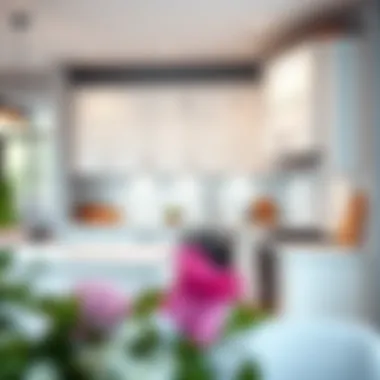
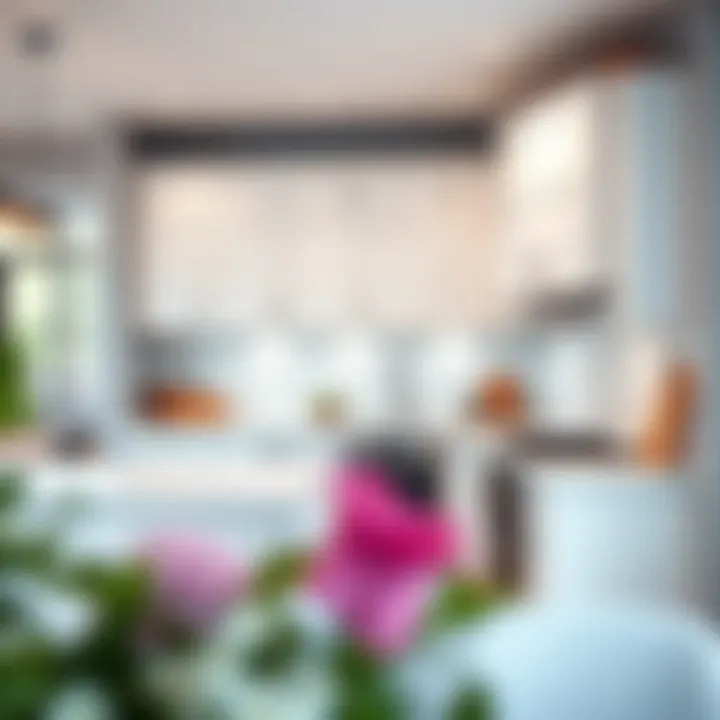
Overall, preparation minimizes complications and reduces installation time. By taking these steps, you’re setting yourself up for a successful outcome that enhances the aesthetic and functionality of your white cabinet doors.
Pricing Aspects
When setting out to explore white cabinet doors, understanding the pricing aspects is absolutely crucial. The cost can significantly influence the choices a homeowner or designer makes. A well-planned budget allows for a more extensive selection and ensures that both quality and aesthetic meet expectations. Knowing your budget range helps in deciding between materials, styles, and even customizations, aiding in a smoother selection process that aligns with your overall design vision.
Factors Affecting Cost
Pricing for white cabinet doors isn't just a matter of numbers; it varies based on several factors which one should consider carefully:
- Material Quality: Solid wood doors generally fetch higher prices than MDF or particleboard due to their durability and aesthetic appeal. High-grade wood like cherry or walnut often carries a premium.
- Design Complexity: Intricate styles, like raised-panel designs, may cost more than straightforward flat-panel options. Custom shapes and unique detailing also add to the labor costs.
- Finish and Coating: The type of paint or finish has an effect too. A high-gloss, durable finish may elevate the price compared to a matte one. Custom finishes can be an added expense.
- Size and Dimensions: Standard sizes are usually cheaper, while custom sizes can lead to increased material and labor costs. It’s vital to measure accurately to avoid unexpected purchases.
- Vendor Selection: Different vendors may have varying price points. Comparing local showrooms with online retailers can reveal substantial price differences for the same product.
Comparative Pricing Analysis
It is wise to undertake a comparative pricing analysis before finalizing a purchase. This means looking at multiple vendors to get a sense of what a fair price is for the white cabinet doors that fit your style and requirements. Here’s how to approach it:
- Gather Data: Make a list of potential vendors, both online and local. Websites like Home Depot and Lowe's provide a range of options and prices. Don’t overlook specialty suppliers who might have unique offerings.
- Analyze Similar Products: Look for doors with similar specifications, material types, and finishes across different retailers. This helps in establishing a baseline for costs.
- Read Customer Reviews: Understanding past customer experiences, especially concerning pricing versus product quality, can provide insights that help in making an informed choice. Sites like Reddit can be tremendously helpful, as you may find discussions that offer firsthand experiences.
- Calculate Total Costs: Remember to factor in shipping and installation costs if applicable. Sometimes the lowest price on a product might not account for these additional expenses, leading to unexpected financial strain.
- Negotiate Price: Many vendors may be willing to negotiate. If a cabinet door you've been eyeing is priced a bit high, don’t hesitate to ask for a better deal. It’s that simple—sometimes just asking can lead to saving money.
"Being informed about the pricing landscape empowers consumers to make choices that are not only economically sound but also stylish and functional."
By keeping these considerations and strategies in mind, homeowners and designers alike can navigate the often tricky waters of pricing, ensuring they make selections that align with their aesthetic goals and budget constraints.
Quality Considerations
When diving into the world of white cabinet doors, one can't overlook the importance of quality considerations. It’s not just about picking a pretty face for your cabinet; it’s about ensuring longevity, durability, and overall satisfaction with your investment. After all, a well-made cabinet can elevate your space, while a poor-quality option can lead to frustration and mounting expenses down the line.
Evaluating Durability
Durability is of utmost importance when selecting white cabinet doors. How can one be certain that the choice will withstand the test of time? Well, the type of material plays a pivotal role. For example, solid wood doors tend to last longer than their MDF counterparts. When evaluating a cabinet door’s durability, consider these factors:
- Material Strength: Look for solid wood or high-grade plywood, as these usually provide better durability compared to cheaper materials like particleboard.
- Construction Quality: Pay attention to how the doors are constructed. Are they made with reinforced joints? This can make a world of difference in durability.
- Surface Finish: A good finish not only enhances appearance but also protects against scratches and moisture. A high-quality paint or stain can help maintain the integrity of the door's surface over the years.
If you’re considering a supplier, ask questions about the materials used and the manufacturing process. It’s worth the extra effort to ensure your white cabinet doors won’t warp or chip in a few short years.
"Investing in quality is not just about spending money; it’s about securing value for years to come."
Understanding Warranty Options
Warranties often tell a compelling story about the quality of the product. If a manufacturer is confident enough to offer a solid warranty, it speaks volumes about their trust in the durability of their cabinet doors. Here are a few points you should keep in mind:
- Length of Warranty: A longer warranty typically indicates a more durable product. Many reputable manufacturers offer warranties ranging from five years to a lifetime.
- Coverage Details: Understand what the warranty covers. Does it include structural work, or is it limited to paint or finish defects? The more comprehensive, the better.
- Claim Process: It's essential to know how easy it is to file a warranty claim. A complicated process can become a headache if you need to rely on it.
In summary, delving into quality considerations requires careful thought and research. By focusing on durability and understanding warranty options, homeowners can better navigate the intricate landscape of white cabinet doors. Making an informed choice is not only wise for aesthetics but serves as a long-term investment in your home.
Finishing Touches
Finishing touches play an essential role in enhancing the aesthetic appeal and functionality of white cabinet doors. They can truly differentiate a kitchen or bathroom, transforming a standard setup into something that resonates with personal style and taste. Paying attention to these fine details can make the difference between a passable design and one that captivates and inspires.
When considering finishing touches for white cabinet doors, there are several factors to think about:
- Hardware Selection: The knobs and handles you choose serve not just as functional elements but also as design features. Hardware can contrast with the white cabinetry, adding an appealing visual element. Alternatively, if you prefer a more seamless look, opt for handles that blend harmoniously with the cabinets.
- Paint and Finish Types: Not every white is made equal. The sheen of the paint—matte, gloss, or satin—can completely change how the cabinetry interacts with light. Choosing the right finish plays a significant part in the overall ambiance of the space. For instance, a high-gloss finish can bring a modern vibe, while a matte finish may evoke a more classic or rustic feel.
- Trim and Molding: Custom trim and molding can give your cabinets a refined look. Think about crown molding for the top of your cabinets to draw the eye upward, or baseboards to ground them in the space. These elements contribute not only to visual interest but also to a sense of luxury and completeness.
"Investing in the finer details can elevate your space from ordinary to extraordinary," says renowned interior designer Sarah Thompson.
Choosing the Right Accessories
Choosing the right accessories for your white cabinet doors is not just about aesthetics; it's about functionality too. Function meets form when the right accessories are selected.
Here are key considerations:
- Knobs and Pulls: A range of styles is available—from contemporary geometric shapes to artisanal handcrafted options. Knobs can be an opportunity to introduce a splash of color, material, or pattern that complements or contrasts with the cabinetry.
- Soft-Close Mechanisms: These mechanisms aren’t visible but significantly enhance usability. They prevent slamming, reduce noise, and prolong the life of the cabinets. Especially in busy kitchens, this feature adds a touch of convenience that homeowners appreciate.
- Lighting: Integrated lighting or under-cabinet options can enhance the beauty of white cabinetry. Soft lighting can highlight textures and finishes while making spaces feel more inviting.
Creating Cohesive Design
Creating a cohesive design around your white cabinet doors isn’t just about matching colors or styles. It requires thoughtful integration of various elements in your space.
Consider these aspects:
- Color Palette: While white is a classic and versatile color, its effectiveness is amplified by a carefully chosen color palette. Utilizing complementary colors for walls or backsplash tiles creates a harmonious flow. A soft grey or muted blue can enhance warmth and complement the freshness of white cabinets.
- Textures: Mix and match different materials to bring depth and interest into the kitchen. Combining smooth white surfaces with textured backsplashes or wooden elements can balance sleekness and coziness.
- Design Themes: Whether you're leaning toward a modern minimalist approach or a more farmhouse-inspired style, sticking to a theme helps create visual coherence. It assists in making sure nothing feels out of place, ensuring that your cabinetry works in concert with other design features.
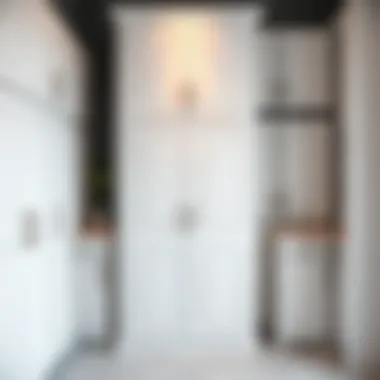

Sourcing White Cabinet Doors
Finding the right white cabinet doors is a journey filled with potential and opportunities, acting as a pivotal point in the overall aesthetics and functionality of a home. Whether you are gearing up for a full kitchen remodel or simply looking to refresh your cabinetry, determining where to purchase your cabinet doors can make all the difference. In this section, we’ll navigate through the choices available for sourcing these essential fixtures, and what you need to keep in mind.
Local vs. Online Vendors
When it comes to sourcing white cabinet doors, one can’t overlook the age-old debate of local versus online vendors. There’s something undeniably appealing about stepping into a brick-and-mortar store. It’s tactile. You can feel the material, check the finish, see the true color—something that often gets lost in digital images. That said, local vendors may offer a limited selection and potentially higher prices compared to their online counterparts.
On the flip side, online vendors can provide an extensive range of styles and price points at your fingertips. You can browse through thousands of options while sitting in your pajamas. Sites like HomeDepot.com or Lowe's, for example, provide comprehensive catalogs that are often just a click away.
However, online shopping does come with its own set of challenges. For instance, the risk of misjudging color or texture is higher since you cannot physically see or interact with the product. Additionally, shipping costs can add to the overall expense, and delays in delivery can be quite frustrating.
In summary, both options have their ups and downs:
- Local vendors:
- Online vendors:
- Pros: Direct interaction, immediate purchase, local support.
- Cons: Limited selection, generally higher prices.
- Pros: Broader range, often competitive pricing, convenience.
- Cons: Color accuracy issues, potential shipping costs, delivery delays.
Given these points, the ideal avenue may vary depending on personal priorities. A mixed approach might be the best route: visiting local stores for feel and style, then checking online for best pricing.
Evaluating Vendor Reputations
Before making any purchasing decision, evaluating vendor reputations is crucial. The quality of white cabinet doors can vary significantly based on who you choose to buy from. A supplier with a stellar reputation is often a reliable indication of good products and customer service. But how do you gauge that reputation? Here are some practical steps:
- Read Reviews: Look for reviews on platforms such as Yelp or Google to get feedback from previous customers. Check both positive and negative sentiments to get a well-rounded perspective.
- Ask for Recommendations: Speak to friends or professionals in the industry. Personal experiences can provide invaluable insights.
- Check Their Portfolio: A well-established vendor often showcases their past work. Examine the styles and finishes they offer—does their portfolio align with your aesthetic tastes?
- Assess Customer Service: Reach out with questions about products or services. Responsive and helpful customer service can be a telltale sign of a reputable vendor.
- Look for Accreditations: Confirm whether the vendor has industry certifications, which can often assure you of their credibility.
By taking these steps, you ensure that you are not simply buying a product but investing in quality and peace of mind. A reputable vendor not only meets your immediate needs but stands by their products long after the sale has been made.
"The vendor's reputation isn't just a nice-to-have; it's a foundation for a smooth and satisfying buying experience."
More about choosing cabinet styles can be found here.
Join the discussion on cabinet design on Reddit.
For more home improvement tips, check out HomeDepot.com
Trends in Cabinet Design
The realm of cabinet design is always in motion, with styles and preferences shifting to reflect contemporary tastes and sustainable practices. In this fast-paced market, recognizing trends in cabinet design is essential for homeowners, designers, and retailers. Not only does it enhance the aesthetic appeal of a space, but it can also increase property value and create a more functional environment. By staying updated with current trends, you can make informed choices that blend artistry with practicality.
Stylish Innovations
The concept of stylish innovations in cabinet design refers to fresh approaches and unique styles that redefine how we perceive storage solutions. One such trend is the use of two-tone cabinetry. This involves mixing and matching colors, such as glossy white doors paired with darker wooden frames, adding depth and visual intrigue to kitchens and bathrooms.
Another innovation gaining traction is the incorporation of open shelving. While traditional cabinet doors offer privacy and concealment, open shelves create an airy feel, making it easier to display decorative items and frequently used kitchenware. This design choice not only emphasizes functionality but also invites personal expression, allowing homeowners to showcase their taste.
Considerations for stylish innovations in cabinet design also extend to smart technology. More homeowners are opting for cabinets equipped with lighting and charging ports that cater to modern living. Sensing lights that activate when doors open or integrated electrical outlets for gadgets are making cabinets not just storage units but integral parts of a high-tech home.
"Embracing stylish innovations can turn an ordinary kitchen into a vibrant, welcoming space that reflects your unique personality."
Sustainability in Design
Sustainability has emerged as a guiding principle in cabinet design, reflecting a broader shift towards eco-friendly living. Homeowners are now considering materials sourced from sustainable forestry, ensuring that their cabinet doors do not contribute to deforestation or habitat destruction. This not only benefits the environment but also adds a layer of ethical responsibility to interior design.
Moreover, the rise of low-VOC finishes is a testament to the industry's response to health and safety concerns. Volatile organic compounds, found in paints and finishes, can lead to indoor air pollution. Opting for cabinetry treated with low-VOC solutions promotes a healthier living space while maintaining durable finishes that resist wear and tear.
Another emerging trend is the rethinking of manufacturing processes. Many manufacturers are focusing on reducing waste by using remnants and offcuts from other projects to create beautiful cabinetry. This not only minimizes landfill waste but often results in unique, one-of-a-kind designs that tell a story.
As we consider sustainability in design, it becomes clear that the choices made in cabinet selection carry weight. Choosing earth-friendly options isn't merely a trend; it embodies a commitment to creating a healthier planet for future generations. By integrating sustainable practices into your home, you are not just making aesthetic decisions; you are contributing to a larger movement towards ecological responsibility.
Final Thoughts
As we wrap up our exploration of white cabinet doors, it’s essential to reflect on the various elements that have been discussed throughout the article. This topic isn't merely about choosing a color or style; it's about understanding the broader implications of these design choices in relation to your living space.
Summarizing Key Points
First and foremost, white cabinet doors stand out for their ability to brighten a room and create a sense of openness. It's not just about aesthetics, though; their functionality and versatility play a crucial role in modern home design. We've delved into the different styles — from Shaker to flat-panel designs, each with its personality and charm. Beyond style, the material choices we covered, such as solid wood versus MDF or laminate, highlight how durability and maintenance can influence your decision.
Furthermore, we touched on customization options, which allow homeowners to tailor their cabinets to fit their unique tastes, adding that personal flair. Installation methods also matter, especially when weighing the pros and cons of professional help versus DIY attempts. Not to forget, pricing—knowing what factors can affect cost helps in setting a budget without compromising quality.
In summary, the decision regarding white cabinet doors shouldn't be rushed. Factors from design to material choices must align with your specific needs and preferences, contributing to the overall atmosphere of your home.
Guidance for Next Steps
So what’s next? Well, it’s time to take these insights and start envisioning how white cabinetry can elevate your space. Here’s a roadmap to guide you forward:
- Assess your space: Measure your kitchen or bathroom to determine how many cabinets you'll need.
- Define your style: Look through design magazines or online platforms like Pinterest to gather inspiration. The more you know about what you like, the smoother your selection process will be.
- Visit showrooms: If possible, see the cabinet doors in person. This helps evaluate the quality of materials firsthand and provides a better sense of color and finish.
- Make a list of must-haves: Identify which features matter most to you—durability, ease of cleaning, or perhaps specific finish options.
- Consult with professionals: If you’re unsure, this is a great time to engage with experienced designers or vendors. They can offer practical advice tailored to your needs.
- Budget appropriately: With all the insights gathered, outline a realistic budget factoring in not just the purchase price, but also installation and any additional customization.
Taking these steps will not only help you make informed decisions but also ensure that your investment in white cabinet doors brings long-lasting satisfaction. After all, a well-chosen cabinet can transform your space, making it both functional and stylish.



